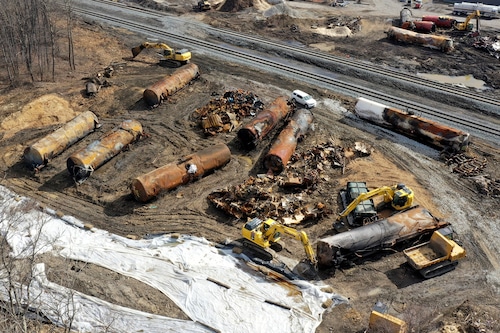By Associated Press’s Josh Funk
In a rush of fresh lawsuits, a lawsuit has been filed ahead of Monday’s second anniversary of the hazardous catastrophe near the Ohio-Pennsylvania border, claiming for the first time that the 2023 East Palestine train derailment caused deaths.
Along with President Donald Trump’s recently approved Environmental Protection Agency chief, Lee Zeldin, Vice President JD Vance is also scheduled to visit the small community near the accident site that he formerly represented as a senator on Monday.
The first seven wrongful death claims against Norfolk Southern Railroad, including the loss of a one-week-old infant, are included in the new lawsuit that will be made public later on Monday. Additionally, it claims that the railroad and its contractors failed to tell locals about the health dangers and that the cleanup was poorly executed, despite approval from EPA and Centers for Disease Control and Prevention officials. Numerous other parties to the case mention persistent, inexplicable health issues in addition to worries that something more terrible might arise.
Truth is what our clients seek. Regarding the approximately 750 individuals she represents, lawyer Kristina Baehr stated that they desire openness. They are curious about the things that have been kept hidden from them. They are curious as to what transpired and why. They also desire accountability.
The complaint doesn’t go into detail regarding the fatalities, but it does give some examples of the long-lasting effects on families.
Over the past week, at least nine additional lawsuits have been filed by people and companies who claim that the railroad’s greed caused the derailment and that the $600 million class-action settlement doesn’t provide nearly enough compensation or sanctions to encourage the railroad to stop derailments in the future. The monetary sum is but a minor portion of the railroad’s $12.1 billion in income during the last two years.
On February 3, 2023, an overheating bearing collapsed, sending dozens of rail cars flying off the tracks. A number of the vehicles transporting dangerous goods burst and released their flammable payload. Three days later, however, officials blasted open five tank cars loaded with vinyl chloride and burnt the deadly plastic element out of fear that it would explode, worsening the disaster.
The controversial vent and burn operation was never necessary, according to National Transportation Safety Board investigators, since the railroad disregarded information that the tank cars were actually beginning to cool down and wouldn’t explode. There was never any indication that the tank cars wouldn’t explode, according to the state and municipal officials who finally decided to discharge and burn the vinyl chloride, creating a dense, black smoke plume that swept across the town and surrounding area.
The EPA has regulations to adhere to, but they choose not to do so. According to Baehr, the EPA was too preoccupied with getting the train back on track to keep the public safe.
Questions concerning the latest lawsuit and other federal claims made against the EPA and CDC were not immediately answered by officials. However, the EPA has previously justified the agency’s involvement in the vent and burn operation by claiming that their sole purpose was to quantify the ensuing contamination and offer advice on the possible outcomes.
According to Baehr, the EPA and CDC’s response to the accident followed a similar pattern to other environmental catastrophes she has been involved with, such as the Navy’s toxic jet fuel spill that tainted Hawaii’s water. According to her, the organizations frequently minimize the dangers to people’s health. The data released by the EPA and the class-action lawyers’ unwillingness to share the findings of their own testing experts have angered locals.
A Norfolk Southern Railroad representative stated that she was unable to comment on the ongoing legal dispute. In a separate settlement with the federal government, Norfolk Southern promised to cover the full cost of the cleanup and set up funds to cover medical examinations and drinking water monitoring. The railroad has also agreed to a $600 million class-action settlement with residents who lived or worked within 20 miles of the derailment. But in both settlements, the railroad denied any misconduct.
As part of the class-action settlement, some homeowners who lived close to the derailment have begun to receive compensation for personal injuries; however, over half of the settlement is still pending while some residents demand greater compensation and additional details regarding the contamination.
Therefore, until the appeal is resolved, the primary payments of up to $70,000 per household will not be made.
In the nine additional new cases, a vineyard, dog kennels, and a pipe maker claimed that the disaster had negatively impacted their operations in a number of ways, from staffing shortages to having to close or relocate due to customer concerns.
Approximately 0.4 kilometers (a quarter of a mile) from the derailment, a business had regular flooding as a result of smoke, debris, and aromas from purported cleanup efforts that reached their premises. At least 116 puppies and three adult dogs died as a result of the hazardous chemicals, according to the dog breeder who ran a business in nearby Pennsylvania.
___
Funk reported from Nebraska’s Omaha. This report was written by Mead Gruver and John Seewer of the Associated Press.

